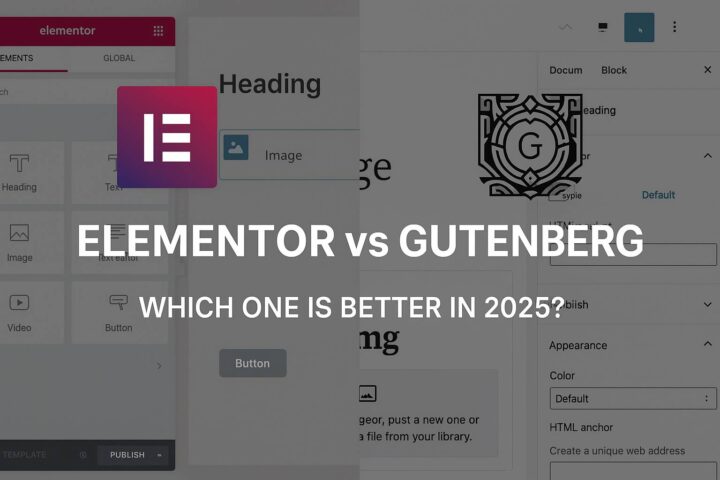Elementor vs Gutenberg (Which One Is Better in 2025?)
When building a WordPress website, choosing the right page builder can make a big difference. The two most popular options—Elementor and Gutenberg—both have their strengths. But which one is better for your needs in 2025?
Let’s break down the Elementor vs Gutenberg debate and help you make an informed decision.

What is Elementor?
Elementor is a popular drag-and-drop page builder plugin for WordPress. Known for its intuitive interface, it allows users to build visually appealing pages without writing a single line of code.
Key Features of Elementor
- Real-time front-end editing
- Pre-designed templates & blocks
- Advanced styling options
- Integration with third-party tools
- Elementor Pro for extended features
What is Gutenberg?
Gutenberg, also known as the WordPress Block Editor, is the default editor built into WordPress since version 5.0. It offers a block-based system for creating content and layouts.
Key Features of Gutenberg:
- Lightweight and fast
- Native to WordPress (no plugin needed)
- Improved over time with regular updates
- Supports custom blocks and block patterns
- Compatible with most themes
Elementor vs Gutenberg – Side-by-Side Comparison
Feature
- Ease of Use
- Design Flexibility
- Speed & Performance
- SEO-Friendliness
- Cost
- Theme Compatibility
- Developer Support
Elementor
- Beginner-friendly
- High
- Slightly heavier
- Great with SEO plugins
- Free & Paid (Pro)
- Works with most themes
- Extensive community
Gutenberg
- Slight learning curve
- Moderate
- Lightweight & fast
- Excellent (native WordPress)
- Free
- Best with block themes
- Backed by WordPress core team
Performance & Speed – Who Wins?
Gutenberg is lighter and faster, as it’s built into the WordPress core. Elementor adds extra scripts and can slow down your site if not optimized well. So in terms of speed and performance, Gutenberg has an edge.
Design and Customization – Elementor Takes the Lead
If you’re looking for advanced design capabilities, Elementor wins hands down. It gives you total control over the layout, typography, spacing, and animations—all without coding.
Gutenberg is improving, but still limited in design freedom compared to Elementor.
SEO Capabilities – A Close Call
Both tools can be optimized for SEO. However:
- Gutenberg, being part of WordPress core, is often more lightweight, which benefits SEO.
- Elementor, with the right settings and SEO plugins (like RankMath or Yoast), can also be highly SEO-friendly.
So it’s a tie—but Gutenberg has a slight edge due to its performance.
Ease of Use – Depends on Your Experience
- Elementor is easier for beginners due to its visual, drag-and-drop editor.
- Gutenberg might take a little time to get used to but offers a smoother publishing experience once mastered.
Elementor vs Gutenberg – Pros and Cons
Pros and Cons of Elementor
Pros:
- Drag-and-drop builder
- Visual editing
- Huge template library
- Highly customizable
Cons:
- Can slow down the site
- Paid features behind Elementor Pro
Pros and Cons of Gutenberg
Pros:
- Lightweight & fast
- Free & built-in
- Regular WordPress updates
- Improved block patterns
Cons:
- Limited design flexibility
- Fewer pre-built templates
Which One Should You Choose in 2025?
Choose Elementor if…
- You want a visually rich design without coding
- You’re building complex landing pages or client websites
- You’re okay with using a plugin and possibly paying for Pro features
Choose Gutenberg if…
- You want a fast, SEO-friendly site
- You’re working with a tight budget
- You prefer using native WordPress features
Final Verdict – Elementor vs Gutenberg
There’s no one-size-fits-all answer. Elementor is better for design flexibility, while Gutenberg is better for speed and simplicity. Choose based on your site goals, budget, and technical skill.
Do You Have An Interesting Project?
- Want To Get Started?
FAQs – Elementor vs Gutenberg
Is Gutenberg replacing Elementor?
No. Gutenberg is the default WordPress editor, but Elementor still offers more design control and is widely used.
Can I use Elementor and Gutenberg together?
Yes! You can use both. Elementor pages can exist alongside Gutenberg posts or sections.
Which is better for SEO – Elementor or Gutenberg?
Gutenberg offers slightly better performance out of the box, which can help with SEO. But Elementor can also be optimized for SEO effectively.
